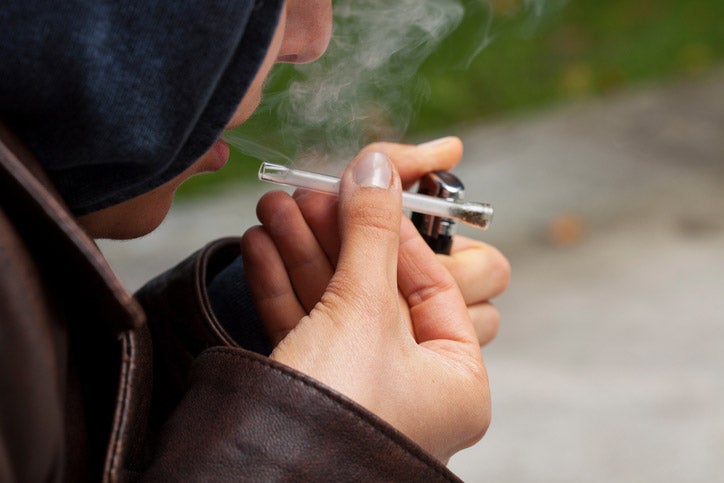Brain scans could help doctors predict adolescents’ problem drug use before it starts
Impulsive behavior in teens can go hand in hand with drug use, but the link is weak and doesn’t necessarily predict future behavior. A Stanford psychologist and colleagues think they can do better, using images of the brain.
There’s an idea out there of what a drug-addled teen is supposed to look like: impulsive, unconscientious, smart, perhaps – but not the most engaged. While personality traits like that could signal danger, not every adolescent who fits that description becomes a problem drug user. So how do you tell who’s who?

A Stanford psychologist and colleagues use brain images in an effort to predict which teens will use drugs later in life. (Image credit: Katarzyna Bialasiewicz / Getty Images)
There’s no perfect answer, but researchers report February 21 in Nature Communications that they’ve found a way to improve our predictions – using brain scans that can tell, in a manner of speaking, who’s bored by the promise of easy money, even when the kids themselves might not realize it.
That conclusion grew out of a collaboration between Brian Knutson, a professor of psychology at Stanford, and Christian Büchel, a professor of medicine at Universitätsklinikum Hamburg Eppendorf. With support from the Stanford Neurosciences Institute’s NeuroChoice program, which Knutson co-directs, the pair started sorting through an intriguing dataset covering, among other things, 144 European adolescents who scored high on a test of what’s called novelty seeking – roughly, the sorts of personality traits that might indicate a kid is at risk for drug or alcohol abuse.
Novelty seeking in a brain scanner
Novelty seeking isn’t inherently bad, Knutson said. On a good day, the urge to take a risk on something new can drive innovation. On a bad day, however, it can lead people to drive recklessly, jump off cliffs and ingest whatever someone hands out at a party. And psychologists know that kids who score high on tests of novelty seeking are on average a bit more likely to abuse drugs. The question was, could there be a better test, one both more precise and more individualized, that could tell whether novelty seeking might turn into something more destructive.
Knutson and Büchel thought so, and they suspected that a brain-scanning test called the Monetary Incentive Delay Task, or MID, could be the answer. Knutson had developed the task early in his career as a way of targeting a part of the brain now known to play a role in mentally processing rewards like money or the high of a drug.
The task works like this. People lie down in an MRI brain scanner to play a simple video game for points, which they can eventually convert to money. More important than the details of the game, however, is this: At the start of each round, each player gets a cue about how many points he stands to win during the round. It’s at that point that players start to anticipate future rewards. For most people, that anticipation alone is enough to kick the brain’s reward centers into gear.
A puzzle and the data to solve it
This plays out differently – and a little puzzlingly – in adolescents who use drugs. Kids’ brains in general respond less when anticipating rewards, compared with adults’ brains. But that effect is even more pronounced when those kids use drugs, which suggests one of two things: Either drugs suppress brain activity, or the suppressed brain activity somehow leads youths to take drugs.
If it’s the latter, then Knutson’s task could predict future drug use. But no one was sure, mainly because no one had measured brain activity in non-drug-using adolescents and compared it to eventual drug use.
No one, that is, except Büchel. As part of the IMAGEN consortium, he and colleagues in Europe had already collected data on around 1,000 14-year-olds as they went through Knutson’s MID task. They had also followed up with each of them two years later to find out if they’d become problem drug users – for example, if they smoked or drank on a daily basis or ever used harder drugs like heroin. Then, Knutson and Büchel focused their attention on 144 adolescents who hadn’t developed drug problems by age 14 but had scored in the top 25 percent on a test of novelty seeking.
Lower anticipation
Analyzing that data, Knutson and Büchel found they could correctly predict whether youngsters would go on to abuse drugs about two-thirds of the time based on how their brains responded to anticipating rewards. This is a substantial improvement over behavioral and personality measures, which correctly distinguished future drug abusers from other novelty-seeking 14-year-olds about 55 percent of the time, only a little better than chance.
“This is just a first step toward something more useful,” Knutson said. “Ultimately the goal – and maybe this is pie in the sky – is to do clinical diagnosis on individual patients” in the hope that doctors could stop drug abuse before it starts, he said.
Knutson said the study first needs to be replicated, and he hopes to follow the kids to see how they do further down the line. Eventually, he said, he may be able not just to predict drug abuse, but also better understand it. “My hope is the signal isn’t just predictive, but also informative with respect to interventions.”
Knutson is also a member Stanford Bio-X. Additional co-authors include the members of the IMAGEN collaboration. The research was funded in part by a grant from the Stanford Neurosciences Institute.
